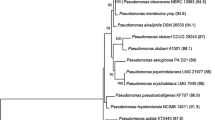Abstract
Pseudomonas aeruginosa CW961, an isolate from the vicinity of a deep-sea hydrothermal vent, grew in the presence of 5 mM Cd2+ and removed Cd2+ from solution. Sulfate was sufficient for growth when Cd2+ was not present in the culture medium; however, thiosulfate was necessary for Cd2+ precipitation and cell survival in the presence of Cd2+.
Similar content being viewed by others
References
Bang S-W, Clark DS, Keasling JD (2000a) Cadmium, lead, and zinc removal by expression of the thiosulfate reductase gene from Salmonella typhimurium in Escherichia coli. Biotechnol. Lett. 22: 1331-1335.
Bang S-W, Clark DS, Keasling JD (2000b) Engineering hydrogen sulfide production and cadmium removal by expression of the thiosulfate reductase gene (phsABC) from Salmonella enterica serovar Typhimurium in Escherichia coli. Appl. Environ. Microbiol. 66: 3939-3944.
Jeanthon C, Prieur D (1990) Susceptibility to heavy metals and characterization of heterotrophic bacteria isolated from two hydrothermal vent polychaete annelids, Alvinella pompejana and Alvinella caudata. Appl. Env. Microbiol. 56: 3308-3314.
Kitaev GA, Uritskaya AA (1999) Analysis of conditions of cadmium sulfide precipitation from qqueous solutions with sodium thiosulfate. Russ. J. Appl. Chem. 72: 592-595.
Mitra RS, Gray RH, Chin B, Bernstein IA (1975) Molecular mechanisms of accomodation in Escherichia coli to toxic levels of Cd2+. J. Bacteriol. 121: 1180-1188.
Neidhardt FC, Bloch PL, Smith DF (1974) Culture medium for enterobacteria. J. Bacteriol. 119: 736-747.
Nies DH, Silver S (1989) Plasmid-determined inducible efflux is responsible for resistance to cadmium, zinc, and cobalt in Alcaligenes eutrophus. J. Bacteriol. 171: 896-900.
Von Damm KL (1990) Seafloor hydrothermal activity: black smoker chemistry and chimneys. Annu. Rev. Earth Planet. Sci. 18: 173-204.
Wang CL, Michels PC, Dawson SC, Kitisakkul S, Baross JA, Keasling JD, Clark DS (1997) Cadmium removal by a new strain of Pseudomonas aeruginosa in aerobic culture. Appl. Environ. Microbiol. 63: 4075-4078.
Whitfield J (1999) Mercurial vents. Nature 401: 755.
Author information
Authors and Affiliations
Rights and permissions
About this article
Cite this article
Wang, C.L., Ozuna, S.C., Clark, D.S. et al. A deep-sea hydrothermal vent isolate, Pseudomonas aeruginosa CW961, requires thiosulfate for Cd2+ tolerance and precipitation. Biotechnology Letters 24, 637–641 (2002). https://doi.org/10.1023/A:1015043324584
Issue Date:
DOI: https://doi.org/10.1023/A:1015043324584




